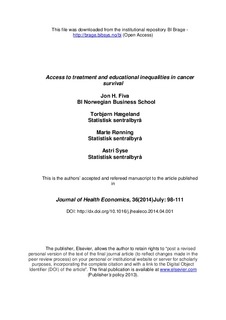| dc.contributor.author | Fiva, Jon H. | |
| dc.contributor.author | Hægeland, Torbjørn | |
| dc.contributor.author | Rønning, Marte | |
| dc.contributor.author | Syse, Astri | |
| dc.date.accessioned | 2014-06-10T12:41:25Z | |
| dc.date.available | 2014-06-10T12:41:25Z | |
| dc.date.issued | 2014 | |
| dc.identifier.citation | Journal of Health Economics, 36(2014)July: 98-111 | nb_NO |
| dc.identifier.issn | 1879-1646 | |
| dc.identifier.uri | http://hdl.handle.net/11250/196288 | |
| dc.description | This is the authors’ accepted and refereed manuscript to the article. Publisher's version is available at elsevier.com | nb_NO |
| dc.description.abstract | The public health care systems in the Nordic countries provide high quality care almost free of charge to all citizens. However, social inequalities in health persist. Previous research has, for example, documented substantial educational inequalities in cancer survival. We investigate to what extent this may be driven by differential access to and utilization of high quality treatment options. Quasi-experimental evidence based on the establishment of regional cancer wards indicates that i) highly educated individuals utilized centralized specialized treatment to a greater extent than less educated patients and ii) the use of such treatment improved these patients' survival. | nb_NO |
| dc.language.iso | eng | nb_NO |
| dc.publisher | Elsevier | nb_NO |
| dc.subject | Education | nb_NO |
| dc.subject | Health | nb_NO |
| dc.subject | Inequality | nb_NO |
| dc.title | Access to treatment and educational inequalities in cancer survival | nb_NO |
| dc.type | Journal article | nb_NO |
| dc.type | Peer reviewed | nb_NO |
| dc.source.pagenumber | 98-111 | nb_NO |
| dc.source.volume | 36 | nb_NO |
| dc.source.journal | Journal of Health Economics | nb_NO |
| dc.source.issue | July | nb_NO |
| dc.identifier.doi | 10.1016/j.jhealeco.2014.04.001 | |
| dc.description.localcode | 2, Forfatterversjon | nb_NO |
